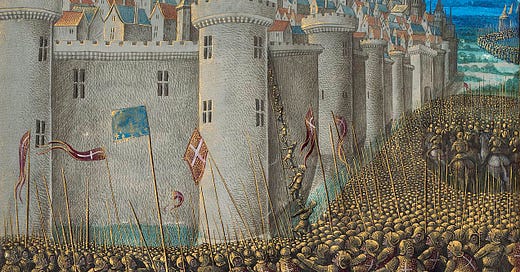Medieval siege tactics
Handsome warriors and good swordsmen,
sieges, catapults and pikes,
and breaking of walls old and new,
and defeat of battalions and towers
I see and hear…
—Troubadour song by Raimbaut de Vaqueiras
Watch any of your favorite medieval movies or tv shows and you are sure to see a ‘pitched battle’ scene - the armies facing each other across an open field, somebody yells ‘charge!’, and off they go into a meleé full of carnage, horses falling, arrows raining down, men getting chopped up, and so on. Agincourt, Falkirk, for example.
It makes for good drama. But it didn’t usually happen like that.
Much like the near-mythical Old West gunfight, there was too much risk in an open battle. In the Old West, usually somebody got it in the back with a shotgun, not ‘guns drawn at high noon in the middle of the street’. More Unforgiven than Gunfight at the OK Corral. In a gunfight, anybody can die. ‘Luck of the draw,’ pun intended. The same with a medieval conflict—in an open battle, anything can happen. At Agincourt in 1415, the French wildly outnumbered the English in both raw count and in knights/men-at-arms (5-1, perhaps 2-1, perhaps less, estimates vary), but they got stuck in the mud, stuck by the Welsh and English longbow archers, then were killed by hammer blows to the head, or by literally drowning in their helmets in mud. It was a devastating and unexpected defeat.
Conflicts usually came to a head in a siege rather than in an open field battle. Someone would hole up in their castle, and be surrounded by their enemy. This can be seen in the career of Richard the Lionheart, especially in his early years.
Reading an account of his time in France before he became king is to be struck by how many castles Richard took. The roll call is striking.
In January of 1175, Richard returns to Aquitaine. There is plotting, plundering, and burning. Uprooted crops and scorched vineyards. A haze of smoke hangs over the land. Richard uses his first siege engine at Castillon. Castles fall like children’s blocks. Aesse, then Limoges. Châteauneuf. Moulineuf, Buteville, Archaic, Montimac. Laches, Merpins. All fallen to Richard’s sword. They blur in his mind, he cannot remember them all. Years pass. Dax. Bayonne. St Pierre. All taken. Lightning campaigns in the depth of winter. Richemont. Genzac. Marcillac. Grouville. Anville. In 1179, he takes Taillebourg, the impregnable, unassailable fortress where Richard had previously hidden from his father. At the critical juncture of the siege, Richard is to be found in the thick of it, leading his troops, laughing as he fights. Then fall Pons, Angouleme, Montignac, all razed. He learns the patient grind of a siege rather than the pitched battle, where what takes years to build may be lost in a single day by chance.
— A short excerpt from my work-in-progress novel, based on Richard’s historical experiences.
A few years after all that, Richard would take yet another seventeen castles in France, putting down rebellions, before ever going on Crusade. It is safe to say the man knew how to take a castle. And yet, in 1199 he died in a careless moment at, of course, a siege.
So, your enemy is holed up behind tall walls inside his castle, how do you defeat him (or her!)?
Depending on the situation, a variety of siege tactics were employed, usually some combination of all of them. As the attacker, the ‘besieger’, your weapons, in addition to your army, are:
Time
Negotiation
Subterfuge
Siege Engines
Tunnels & Mines
As a defender, what are your weapons?
Time
Your castle
Weapons
A relief force
Let’s dig in a bit.
Time, negotiation, subterfuge
As an attacker, your first weapon is time. If you can surround the castle, and you have time, you can simply starve out the castle. Sooner or later they will run out of food and water. Of course not all castles can be surrounded easily. At Acre, the Muslim forces commanded the harbor and so could resupply via ship. This is one of the reasons the siege took over two years to complete.
You could also negotiate the surrender of the castle. A common tactics was to provide safe passage for the inhabitants (as Saladin did when he took Jerusalem), and perhaps their possessions, or otherwise guarantee the occupants would come to no harm. Typically if a castle was taken by storm, the attackers would plunder everything and often slaughter the inhabitants. Not pretty.
Subterfuge. We all know the story of the Trojan Horse. If someone can somehow sneak into the castle, they can open the gate and let in the attackers.
Time is an important dimension to a siege. The Siege of Acre lasted over two years, and only ended when Richard and Philip arrived and brought a massive influx of resources. During that time, both the attackers and defenders require food, water and supplies. Logistics were as or more important than military prowess.
Disease often became a factor in sieges as well. Dysentery was a typical problem for attackers, arising from the unsanitary conditions of a camp with tens of thousands of soldiers and no real plumbing. It is estimated that more Crusaders died of disease than of battle, for example. Attackers and defenders were known to catapult dead or diseased animals (or people) to infect their opponents.
When negotiations failed, the attacks began, with the goal of somehow breaching the walls. Once that was done, defeat was virtually certain. Siege engines are the most well known weapons: trebuchets, mangonels, battering rams, siege towers, and ladders. Although we will see that tunnels often were the key.
Siege engines: Trebuchets and Mangonels
(We are focused here on the era before the introduction of explosives and guns, which would both utterly alter warfare, and sieges.)
Trebuchets and mangonels are rock-throwers, often known by the generic term ‘catapult’. Trebuchets use a huge counter-weight balance to hurl stones and break down walls or buildings. Mangonels were man-powered and used leverage or twisted rope to produce force. At Acre, Richard’s most famous siege, the catapults were named like pets. Richard’s primary trebuchet was nicknamed ‘Bad Neighbor’. The Hospitallers had a catapult that was funded from contributions from soldiers, and had a priest and an offering collection next to it at all times. It was, unsurprisingly, ‘God’s Own Catapult’. The Muslims had a catapult called ‘Evil Cousin’.1
Battering rams might be used to destroy a gate and provide entry. Usually they would be sheltered by a roof to protect the operators from projectiles, fire or boiling water or oil.
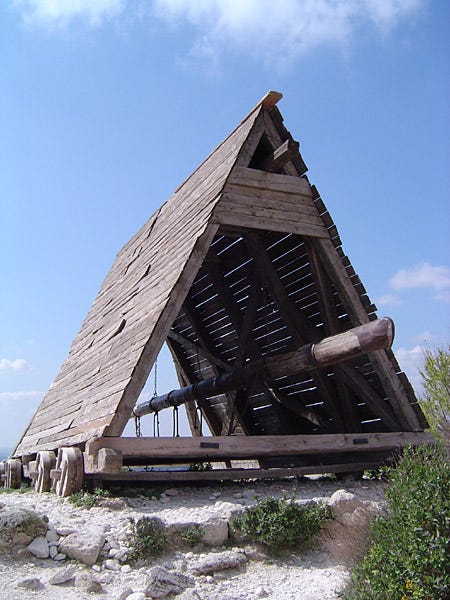
Attackers would also attempt to scale the walls either using normal ladders, or a much more robust wheeled tower. These towers went under a variety of names: Helepolis (Greek ‘taker of cities’), ‘cats’, ‘siege towers’, ‘belfrys’, and they could be enormously tall. The siege towers constructed at Acre by Richard and King Philip of France were perhaps 100’ tall. The defenders would of course try to destroy these towers, mostly by fire, including Greek Fire, so the towers were often covered in hides soaked in vinegar or urine. The towers might have been used to actually go over the wall, but more importantly they would be used to provide covering fire to other attackers, as they could fire down into the city or along the walls.
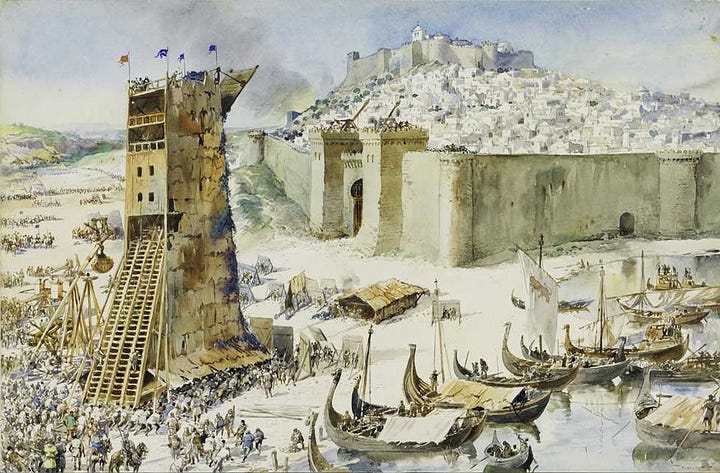
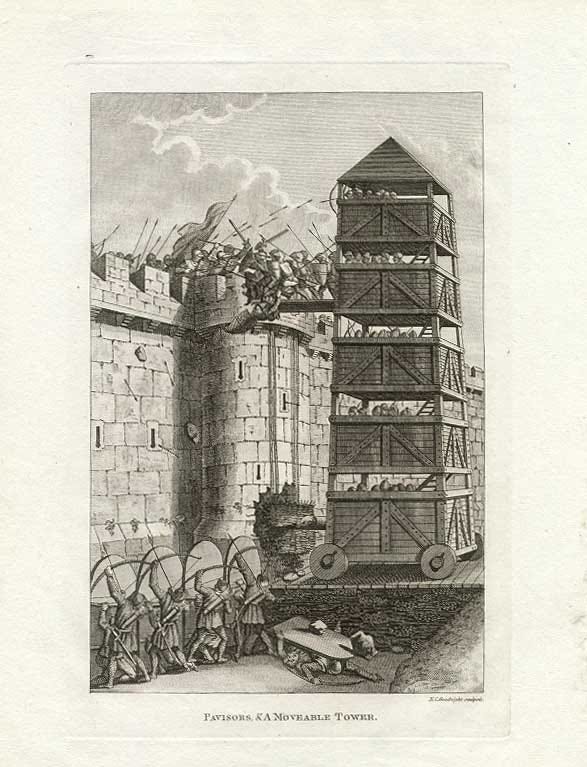
The last weapon, and perhaps the most important, was the mine. The siege of Acre was essentially ended through the successful use of a mine. Tunnelers (‘sappers’) would dig underneath a wall and open up a big area underneath a structure. They would frame in the open area as they went, and when ready, set fire to the structure, which would then collapse, and the tunnel along with it. When the ground collapsed, the structure would collapse along with it. At Acre, the tunnels were lined with pig carcasses, and when burned the pig fat acted as an accelerant, almost an explosive.
To counter the mine, defenders would often dig a counter-mine. They would dig their own tunnel, try to intercept the other tunnel before it could reach the wall, and collapse the tunnel prematurely. At Acre, a counter-mine did in fact reach a Crusader tunnel. However, the Muslims had forced Christian prisoners to dig the counter-mine, and when they broke through, they simply surrendered.
Detecting a mine was interesting business. Sometimes they could simply be seen. At other times, they had to be detected. An interesting technique was to place bowls of water on top of the castle walls and watch the ripples in the bowl, which would reflect disturbances from the mining activity!2
Here’s a wonderful photograph of the extant mining tunnel at Bungay Castle near Norwich, England, from the siege of 1174.
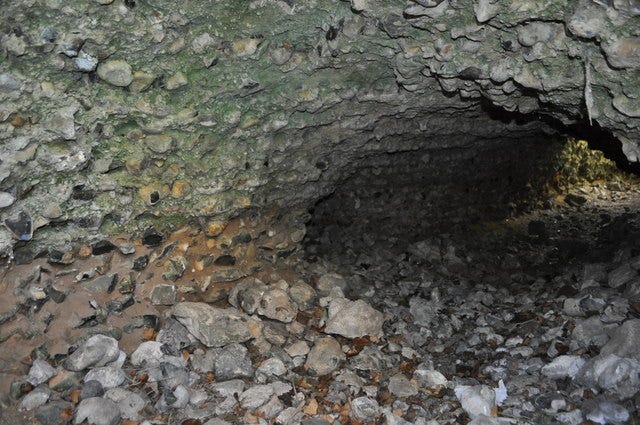
St. Andrews castle in Scotland has an extant mine tunnel, and a countermine tunnel from the (much later) siege of 1547. Here’s a fun video of someone going through the tunnels:
Now, as a defender, in addition to simply waiting out the attack, what do you have going for you? Mainly, the defensive features of your castle.
Architectural features of castles
The walls are the basis of everything. Made of stone and 10-20’ thick (or more). Defenders can walk atop them (battlements, parapets). Structures (machiolations, murder holes) would often be built which protruded over the walls, allowing defenders to fire down on attackers. Crenels and merlons, the alternating rectangular gaps and pillars atop a wall, allow defenders to shoot arrows yet remain protected themselves.
Towers provide additional height, and often protrude outward so that fire can be directed to attackers at the base of a wall. The highest towers provide a vantage to scout the surrounding countryside. A barbican is essentially a specialized tower around a gate into the castle, as those require particular defense.
Arrow slits in the wall provide a small opening that arrows or other projectiles can be fired, without much exposure to the archer.
It is often said that castle stairwells were built to run clockwise, so that attackers coming up had difficulty swinging their swords, and that the stair pitch was designed to explose knee joints in an attacker’s armor, but there is a great deal of argument that these are myths.3
The study of castle architecture is an endless source of amusement for many. Even T.E. Lawrence (“Lawrence of Arabia”) wrote his undergraduate thesis (original here) on the influence of Crusader castle architecture on European architecture.
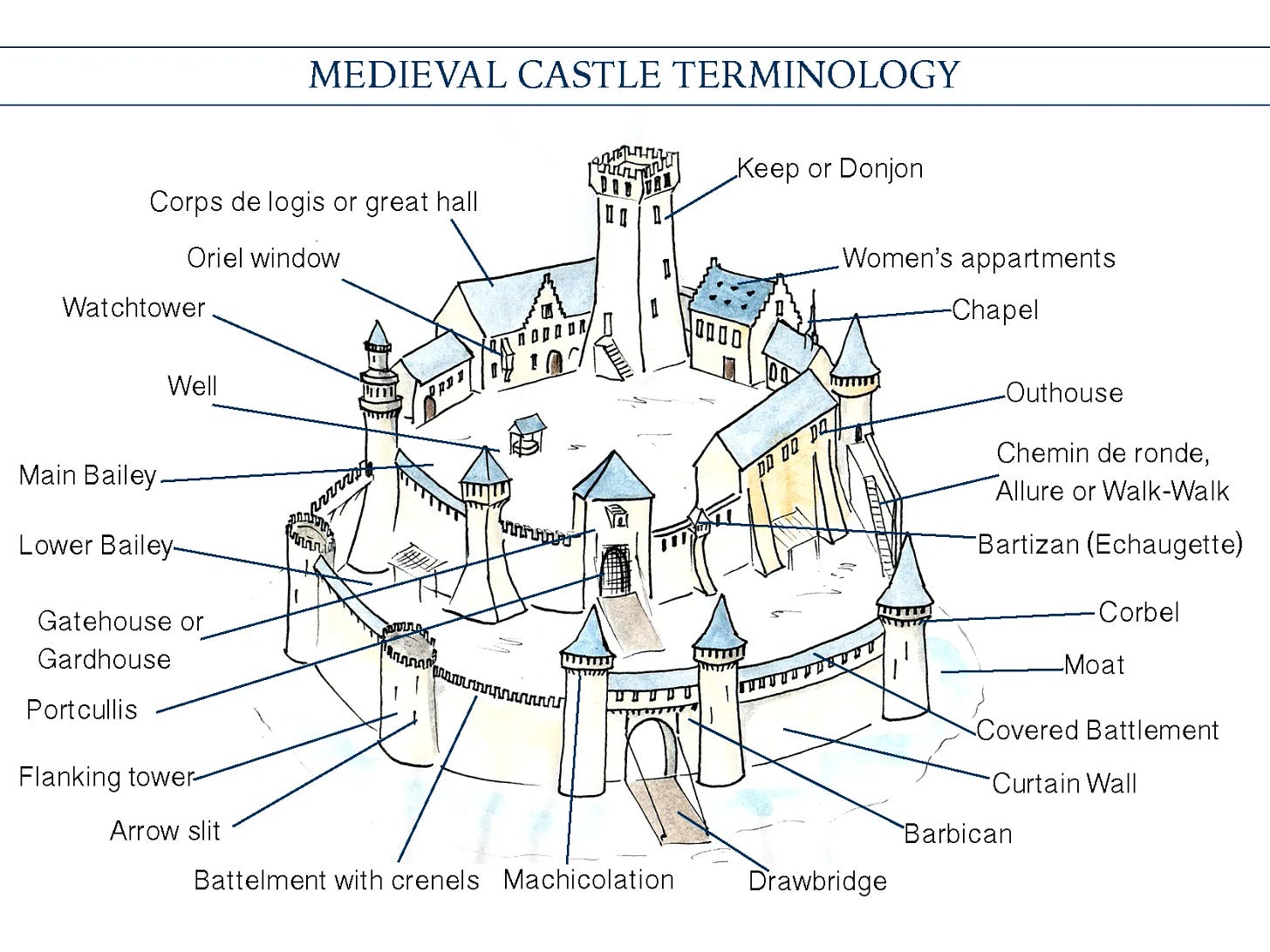
If you have an hour to kill, this video explores castle defences as the creators rebuild a medieval French castle.
Outside the castle itself, one often finds a moat or ditch, which prevents attackers from coming close to the walls (and makes mining/tunnelling even more difficult). At Acre, there was reportedly a ditch that was 90 feet deep!4
Weapons
Castle defenders would of course have similar options to attackers. A ballista, a mounted crossbow, might be found atop the walls. Defenders might have their own trebuchets inside the walls. At Acre, ‘Evil Cousin’ mentioned above, repeatedly struck ‘Bad Neighbor’, rendering it inoperative until it was destroyed.
In addition to arrows, rocks and other projecties, defenders might attack with fire, especially Greek fire (our short history of Greek fire here), and try to burn either the attackers themselves or the structures they were in (towers, rams, or catapults). Sometimes boiling water or oil might be used, but seems more common as a movie trope than an actual defense5—it seems doubtful that many castles would even have a ready suppy of oil (at least of the petroleum variety), and water was often at a premium in a siege.
Lastly, as a defender, you might hope for a relief force from outside the castle to help you. At Acre, the Crusaders were wedged between the castle and Saladin’s larger army, forcing them to defend behind themselves while they attacked the Acre walls on their front.
The siege of Acre was one of Richard’s military masterpieces. While his crusade would ultimately not succeed in taking Jerusalem, Acre would become the heart of the Crusader kingdom for the next one hundred years, until it would again fall in a siege, by the attacking Mamluks, and that event would essentially mark the end of the Crusader kingdom in the Middle East.
History of the Holy War, Ambroise, Marianne Ailes (translator), a contemporary historical account.
Richard the Lionheart, David Miller.

